Development of Computer-Based Tutors (CBTs) for Armed Forces 1. Introduction Modern armed forces operate in an environment where technology, equipment, and warfare strategies evolve rapidly. To remain combat-ready, continuous training and upskilling of personnel are critical. Traditional classroom-based methods, while useful, often fall short in scalability, consistency, and adaptability to emerging technologies. Computer-Based Tutors (CBTs) provide a powerful solution by offering interactive, self-paced, and simulation-driven training. In this regard, Code and Pixels Interactive Technologies Pvt. Ltd., with its proven expertise in Interactive Electronic Technical Manuals (IETMs) and CBT development for defense applications, is uniquely positioned to support the armed forces in deploying advanced digital training systems. Leveraging Code and Pixels’ Experience for the Development of Computer-Based Tutors (CBTs) for Armed Forces
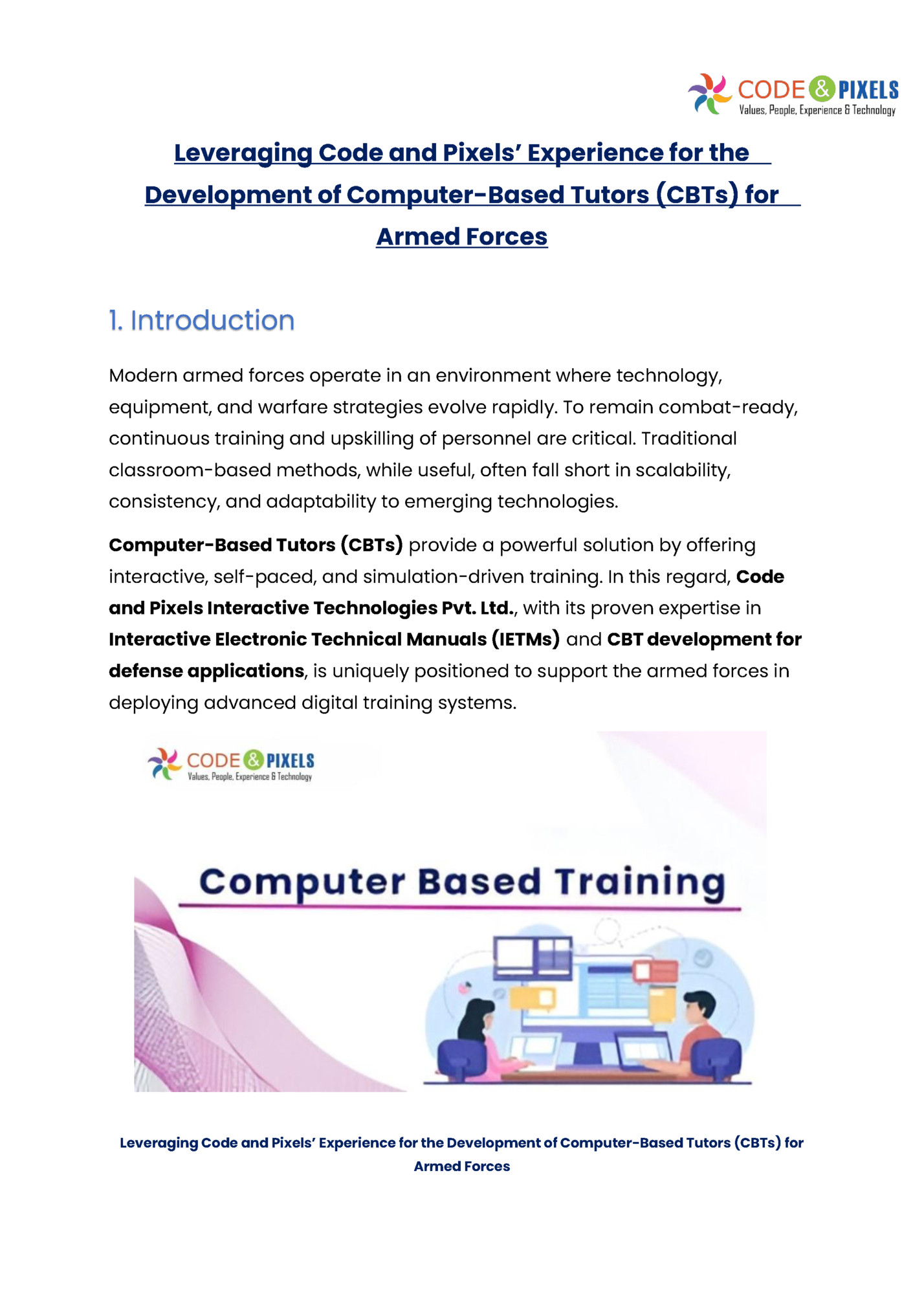
Code and Pixels brings extensive experience in designing and delivering customized digital training solutions for Indian defense organizations. The company has successfully developed IETMs, e-learning solutions, and CBT modules that meet the unique requirements of highly technical and missioncritical defense systems. Key strengths include: • Proven Track Record: Multiple successful projects delivered to Indian armed forces and defense PSUs. • Domain Expertise: Specialized in converting complex defense technical manuals into interactive, user-friendly digital training modules. • Customization: Content tailored to operational protocols, security guidelines, and equipment-specific needs. • Scalability: Solutions that can be deployed seamlessly across multiple bases and training academies. 3. How Code and Pixels’ Experience Can Be Used in Developing CBTs for Armed Forces 3.1 Development of Technical Training Modules o Converting equipment manuals into interactive CBTs for faster learning. o Simplifying complex processes with animations, videos, and stepby-step guides. 3.2 Simulation-Based Learning o Creating realistic simulations of equipment operation, battlefield scenarios, and emergency procedures. Leveraging Code and Pixels’ Experience for the Development of Computer-Based Tutors (CBTs) for Armed Forces
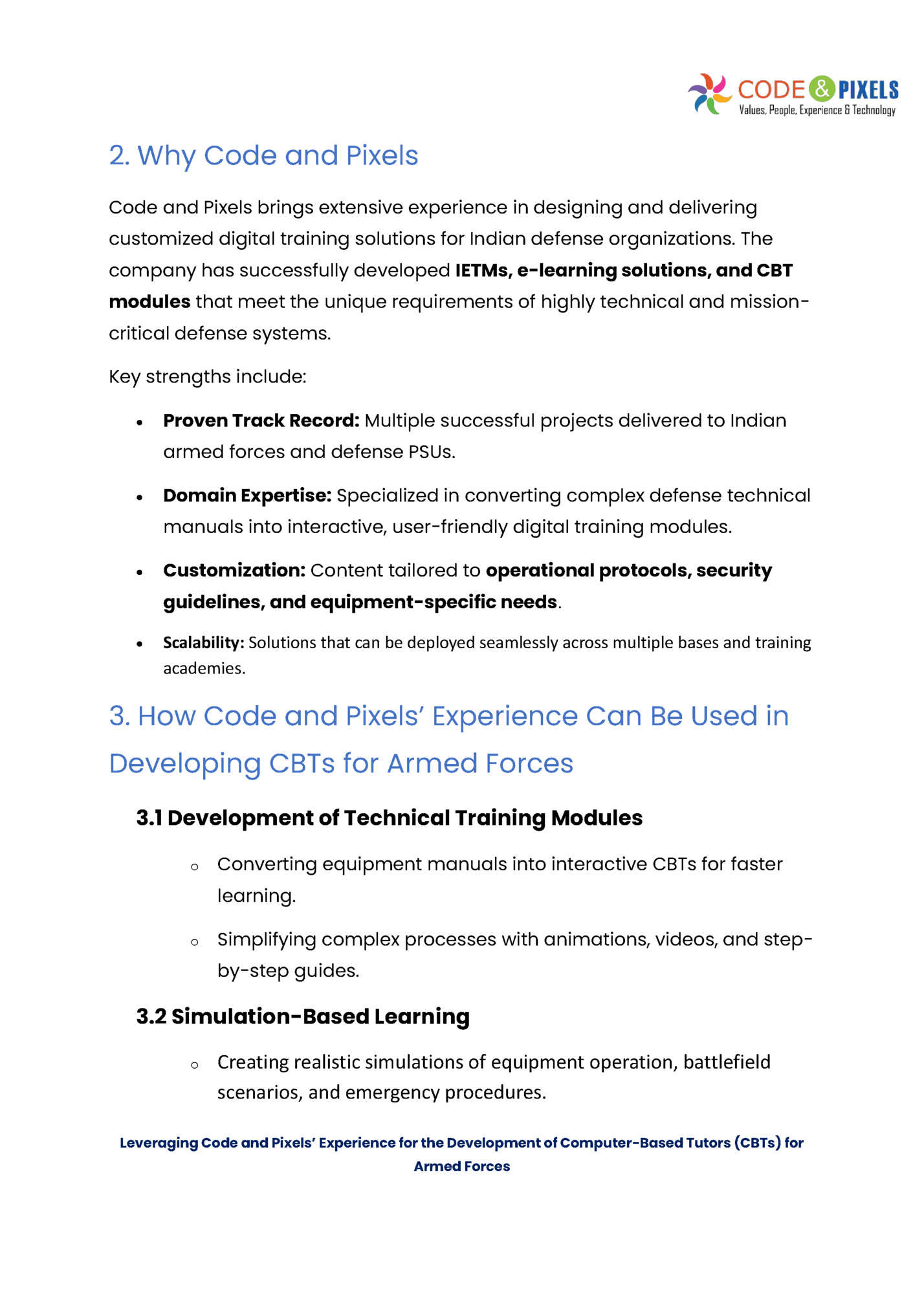
Providing soldiers with a safe, risk-free environment to practice critical skills. 3.3 Standardization of Training o Ensuring uniform, high-quality training across all units and regiments, reducing dependence on instructor variability. Leveraging Code and Pixels’ Experience for the Development of Computer-Based Tutors (CBTs) for Armed Forces
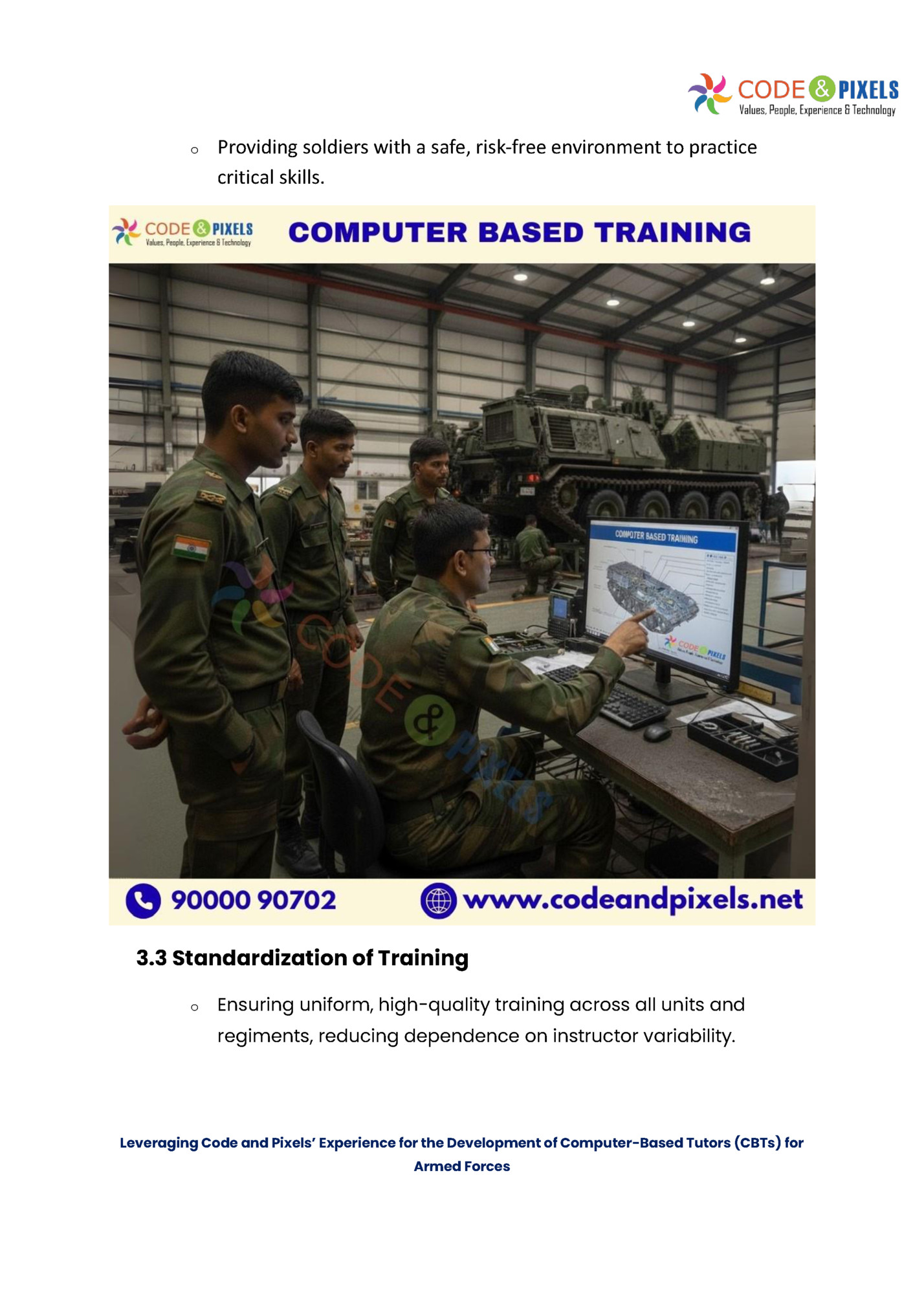
o Allowing personnel to learn at their own pace, revisit difficult topics, and receive instant feedback. 3.5 Cost-Effectiveness o One-time development of CBTs can train thousands of personnel without recurring costs of classroom infrastructure or instructor travel. 3.6 Continuous Updates o Rapidly updating CBT modules as new equipment, technology, or procedures are introduced, ensuring training remains current and relevant. 4. Benefits to Armed Forces • Enhanced Skill Development: Personnel can quickly adapt to new technologies and systems. • Operational Readiness: Soldiers are better prepared for missions through immersive training. • Efficiency: Reduced time and cost compared to traditional training. • Inclusivity: Training accessible to remote and forward-deployed units. • Confidence Building: Practice in simulated environments improves decision-making under pressure. Leveraging Code and Pixels’ Experience for the Development of Computer-Based Tutors (CBTs) for Armed Forces
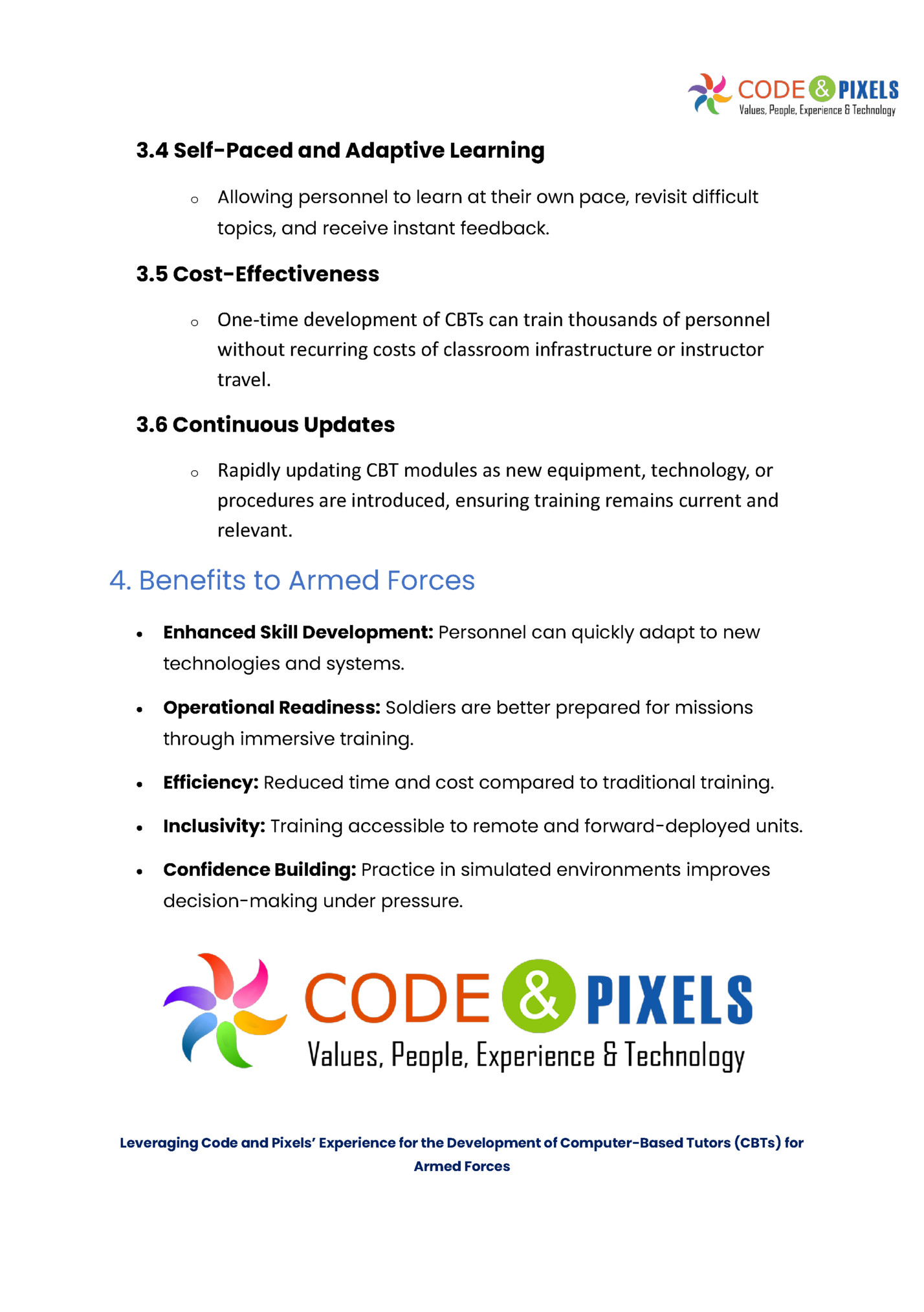
Armed Forces to Upskill 1. Introduction The armed forces of any nation play a crucial role in ensuring security, sovereignty, and peace. In the 21st century, the challenges faced by the military are no longer confined to traditional battlefield operations. Modern warfare involves cyber security, artificial intelligence, drones, advanced communication systems, and data-driven decision-making. To remain prepared and effective, military personnel must constantly update their knowledge and skills. This is where Computer-Based Training (CBT) software emerges as a powerful tool. CBT offers structured, technology-enabled training modules that allow soldiers, officers, and technical staff to learn new skills efficiently. Unlike traditional classroom training, CBT provides flexibility, scalability, and simulation-based environments that mirror real-life military operations. This essay explores how computer-based training software can help the armed forces upskill and stay mission-ready in a rapidly evolving world. 2. Benefits of Computer-Based Training for Armed Forces 2.1 Flexibility and Accessibility One of the most significant advantages of CBT is that it allows personnel to train anytime, anywhere. Military staff deployed in remote or high-risk locations can continue their learning without the need for physical instructors. This ensures that training is not disrupted, even during field operations. How Computer-Based Training Software Can Help Armed Forces to Upskill
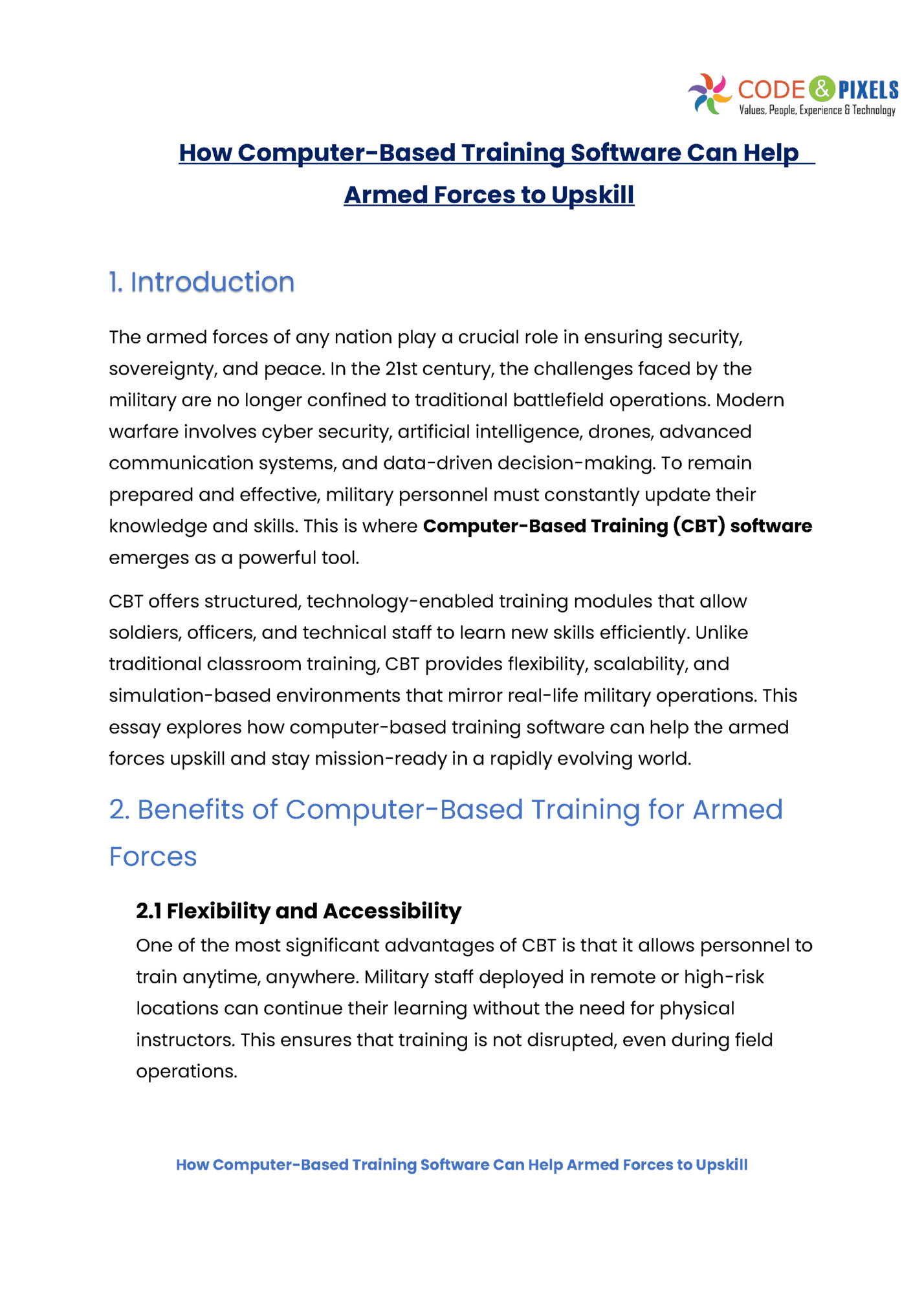
Modern CBT systems incorporate 3D to recreate battlefield conditions, equipment handling, and tactical decision-making exercises. For example, pilots can train in flight simulators, and naval officers can practice navigation in virtual seas. These simulations reduce risk and cost while enhancing readiness. 2.3 Standardization of Training CBT ensures uniformity in the quality of training across different branches and units of the armed forces. Every soldier receives the same structured knowledge and practical exposure, eliminating inconsistencies that can occur in manual teaching methods. 2.4 Cost-Effective Training Traditional training requires infrastructure, travel, and instructor costs. CBT reduces these expenses by providing reusable modules, online assessments, and virtual classrooms. Once developed, a training program can be delivered to thousands of personnel at minimal additional cost. How Computer-Based Training Software Can Help Armed Forces to Upskill
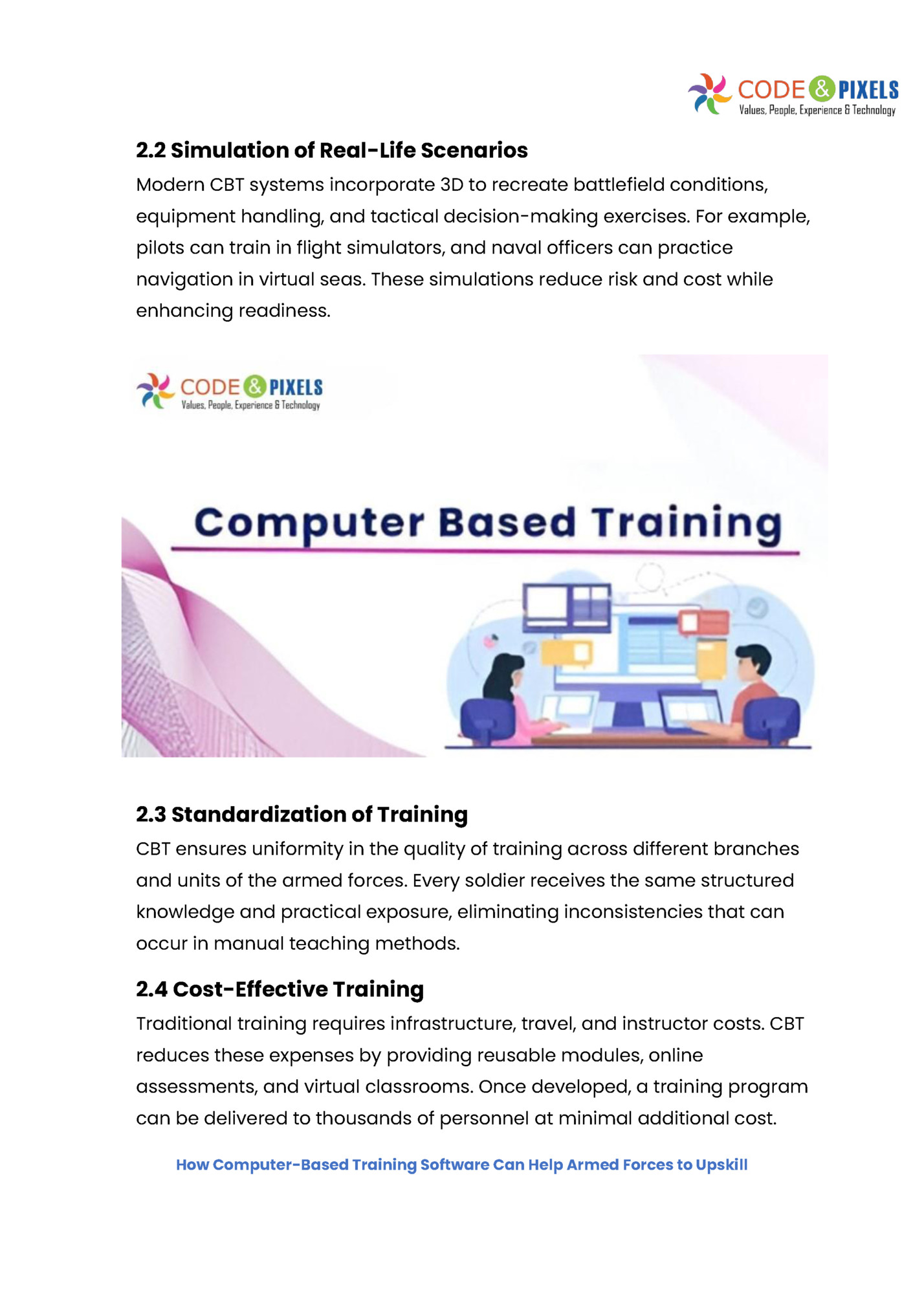
Armed forces personnel come from diverse educational and technical backgrounds. CBT allows individuals to learn at their own speed, revisit difficult modules, and track their progress. This personal learning pace ensures better retention and confidence in applying skills. 2.6 Continuous Skill Upgradation With evolving technologies like drones, cyber defense systems, and advanced weaponry, soldiers must continuously learn and adapt. CBT modules can be updated quickly, keeping the training content relevant and up-to-date with modern threats and equipment. 3. Application Areas of CBT in Armed Forces • • • • • • • Learning to operate and maintain sophisticated military hardware like aircraft, submarines, tanks, and radar systems. Cybersecurity awareness and handling advanced communication tools. Simulated battlefield scenarios for decision-making under pressure. CBT modules on leadership, negotiation, crisis management, and cultural sensitivity for peacekeeping missions. Communication training to work effectively in multinational forces. Programs on mental health, stress management, and resilience. Training on first aid, battlefield medical assistance, and emergency response. 4. Relevance in the Indian Context India, with one of the largest armed forces in the world, faces a wide range of security challenges—from border conflicts to cyber warfare. The need for quick skill upgradation is critical. Computer-Based Training offers a scalable and efficient way to ensure that personnel across the Army, Navy, and Air Force are always up-to-date with the latest technologies and tactics. Indian defense organizations are already adopting digital solutions, including Interactive Electronic Technical Manuals (IETMs), e-learning platforms, and How Computer-Based Training Software Can Help Armed Forces to Upskill
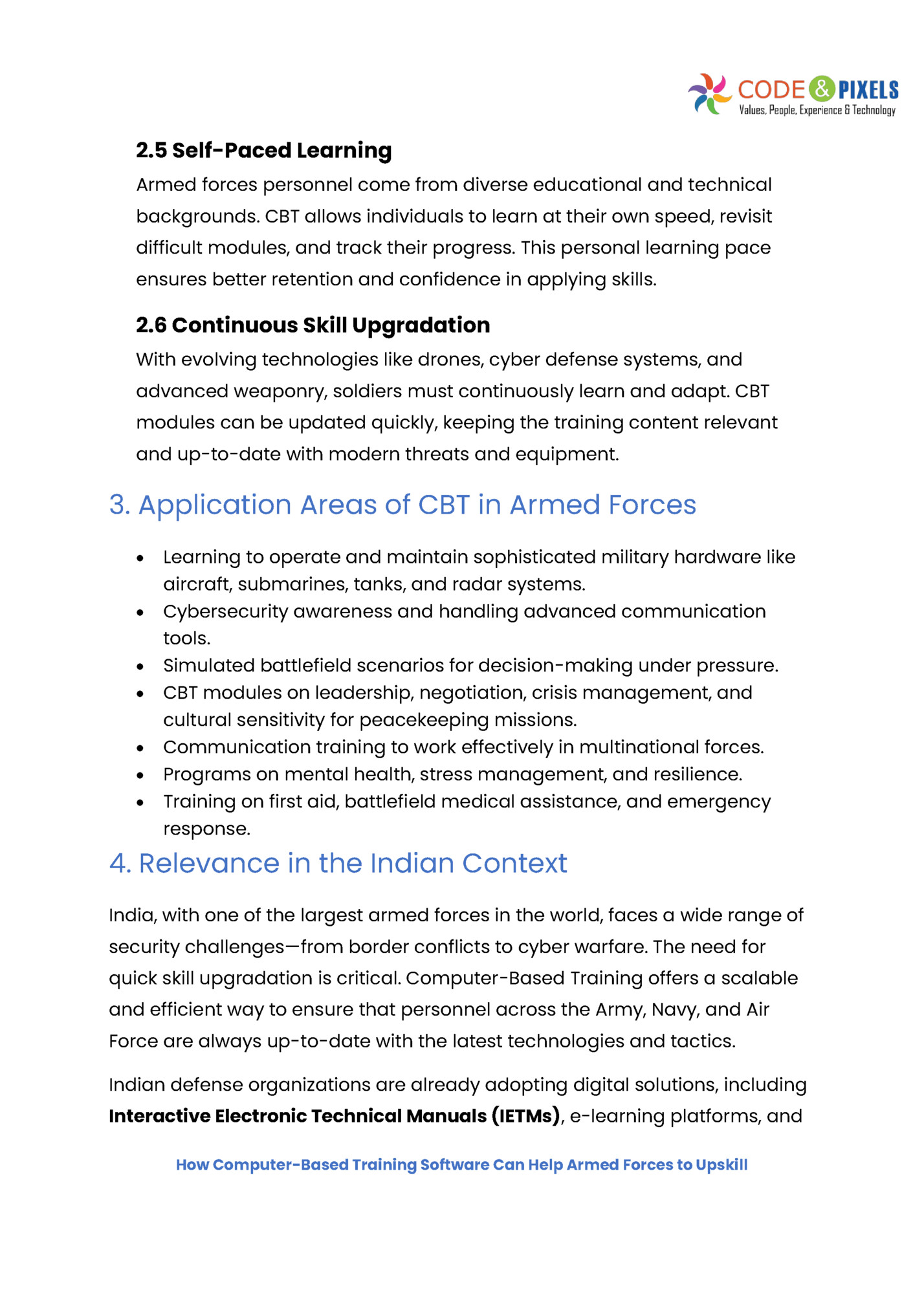
remote and border areas where traditional training is difficult. 5. Challenges in Implementation While CBT offers immense potential, certain challenges must be addressed: • Infrastructure Limitations: Power supply and internet access in remote military bases. How Computer-Based Training Software Can Help Armed Forces to Upskill
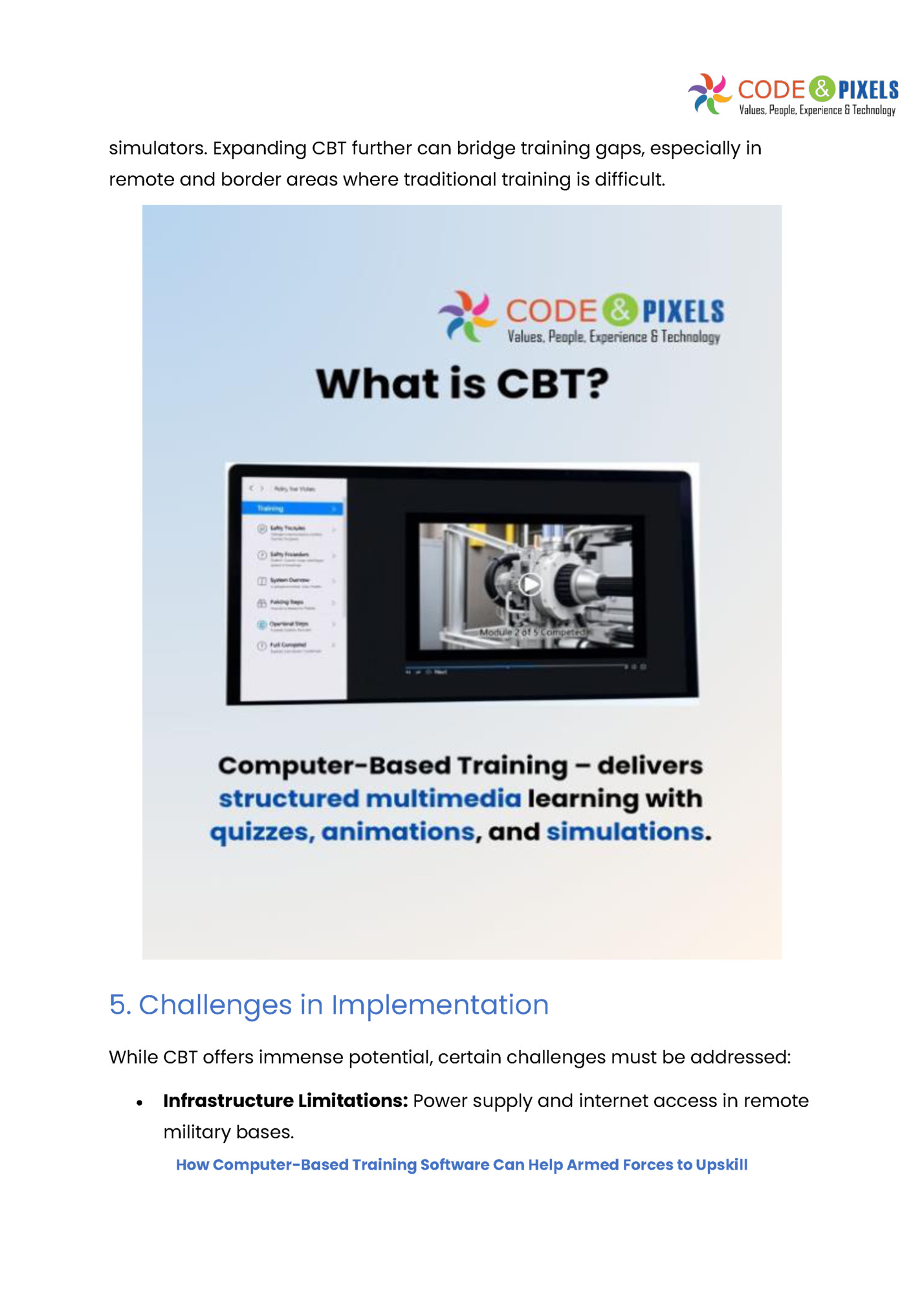
Initial Development Cost: High cost of creating simulation-based modules and software. • Resistance to Change: Personnel accustomed to traditional training may initially resist digital methods. With proper planning, investment, and phased implementation, these challenges can be overcome. How Computer-Based Training Software Can Help Armed Forces to Upskill
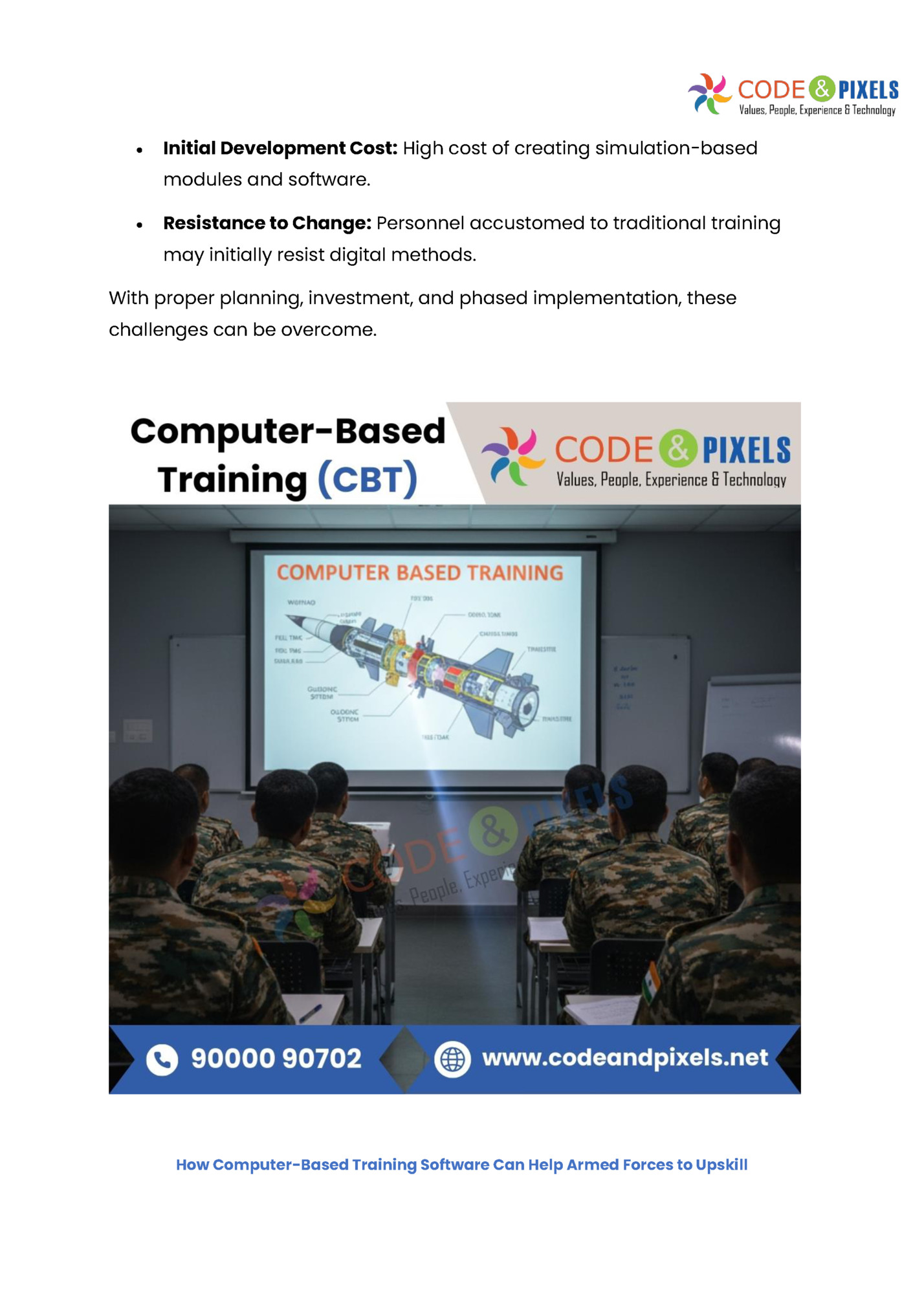
Fleepit Digital © 2021